Ann Tracy: In Her Own Words
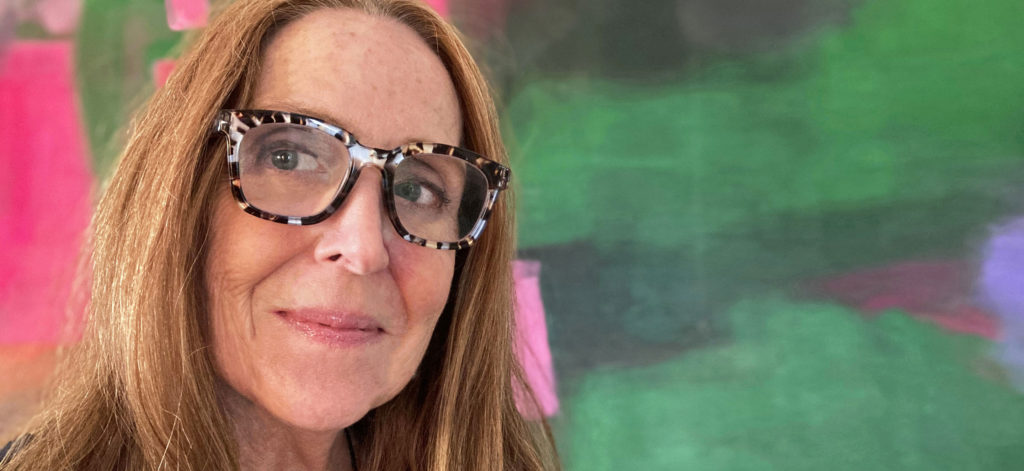
Aug, 24, 2021
ArtistsCommunityPhxArtist Spotlight
Ann Tracy: In Her Own Words
An abstract painter, a walking artist, a photographer, an environmentalist, a survivor of multiple heart defects, stroke, and melanoma. This is Ann Tracy.
Based in Tucson, Ann has made art her life, dedicating herself to exploring the beauty, wisdom and solitude of the natural environment, particularly water. She’s also committed to advocating for the arts at the state and local levels.
Ann received her BFA from the Minneapolis College of Art and Design and attended graduate school at San Francisco Art Institute. She’s received numerous grants to support her work, including those from the Gottlieb Foundation, Artists’ Charitable Fund, Arizona Commission on the Arts, the Arts Foundation for Tucson and Southern Arizona, and others. Her work is included in public and private collections across the United States and in Canada, Mexico, Europe, Africa, and Australia.
We recently spoke with Ann to learn more about her inspirations, her practice, and her unwavering dedication to supporting the arts.
Here’s Ann Tracy, in her own words.
“I don’t need motivation to keep creating. It’s something I’ve always done. To be honest, art has saved me—repeatedly.”
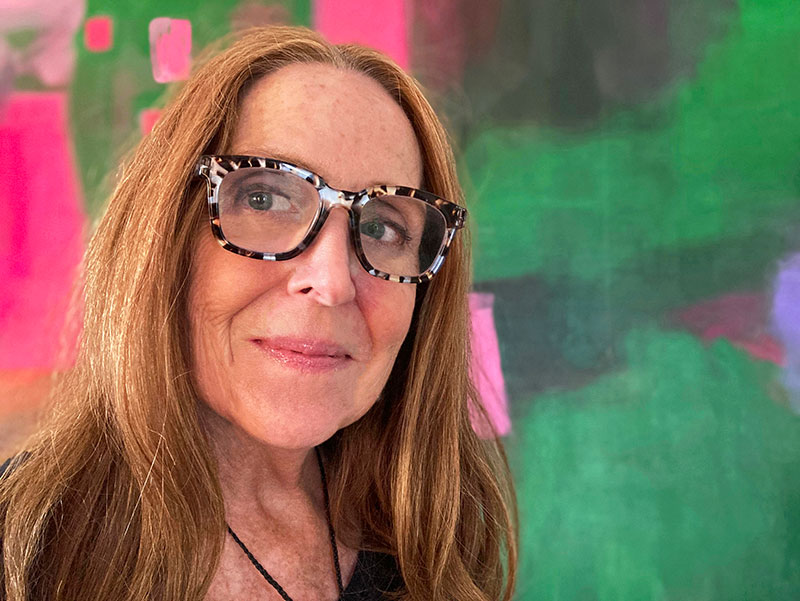
Ann Tracy. Self portrait. Courtesy of the artist.
PhxArt: Tell us about where you’re from and when you first knew you wanted to be an artist.
Ann Tracy: Where I’ve lived is critical to my work as I’m influenced by surroundings. I spent my childhood in Green Isle, Minnesota, a small town outside of Minneapolis. It’s a beautiful area, a combination of flat green farmlands and rolling hills and cliffs along the Minnesota River. As Franz Kline said, “One never shakes their original landscape.”
When I was 12, we moved to an affluent suburb. I got a great education, but I felt out of place until I moved into the city and went to the Minneapolis College of Art and Design (MCAD). I’ve also lived in San Francisco. I’ve been fortunate to make regular trips to Ireland, where I work at a retreat center for artists and writers. But Arizona has been my primary residence, with summers by Lake Superior in Duluth, Minnesota. I guess I’m a wanderer.
As far as when I knew I wanted to be an artist, there was never an a-ha moment. My family was practical, but we were quintessentially Irish; education, literature, and the arts were important. I’ve never looked to art as a way to make a living but rather as a way to have a rich life. It’s kind of crazy to make that leap, but one is brave at 20 and I’m grateful that I chose this path. I don’t need motivation to keep creating. It’s something I’ve always done. To be honest, art has saved me—repeatedly.
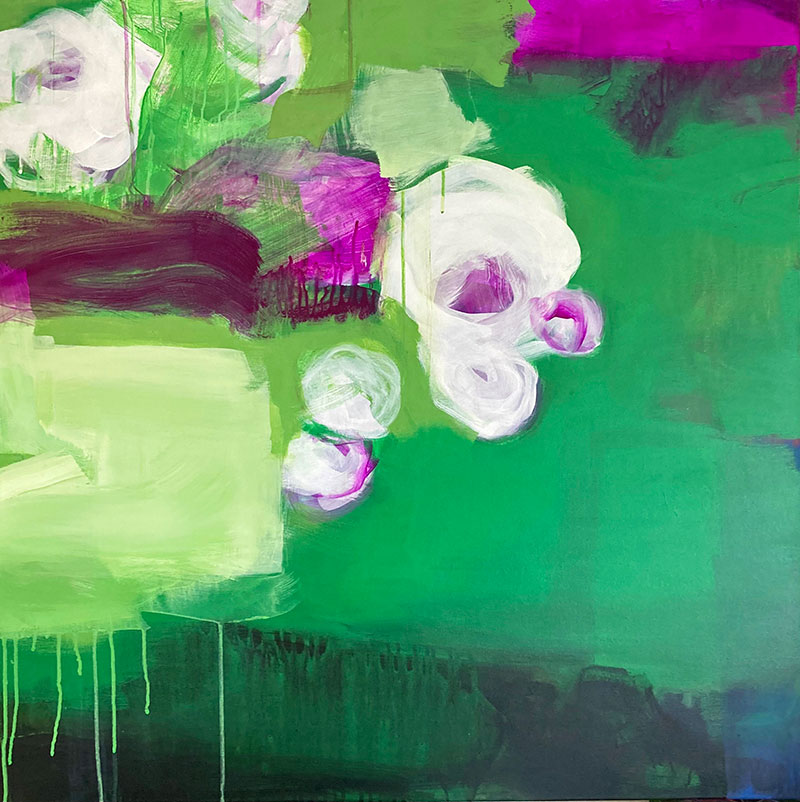
Ann Tracy, Wood Sorrel (Series: When I Didn’t Have a Broken Wing), 2021. Acrylic on canvas. Photo by artist.
PhxArt: What are the media that you prefer to work in, and what topics do you explore through your art?
Tracy: I started in photography but primarily consider myself a painter. I am comfortable with all paint media and switch back and forth. Sometimes I add other materials including sewing, collage, and text.
Most of the time my work is about water. All of the time my work is nature-influenced.
PhxArt: Tell us about some the art you chose to feature in this spotlight. What inspired these pieces, and what inspires your use of color?
Tracy: I started this series six months into the COVID pandemic, when I felt able to settle my creative mind again and dive back into substantial work. The palette used changed completely. With so much tragedy and division going on, our world needed bright color. These are all large-scale abstractions of specific flower species. Bring on the fuchsia, violet, and pure green!
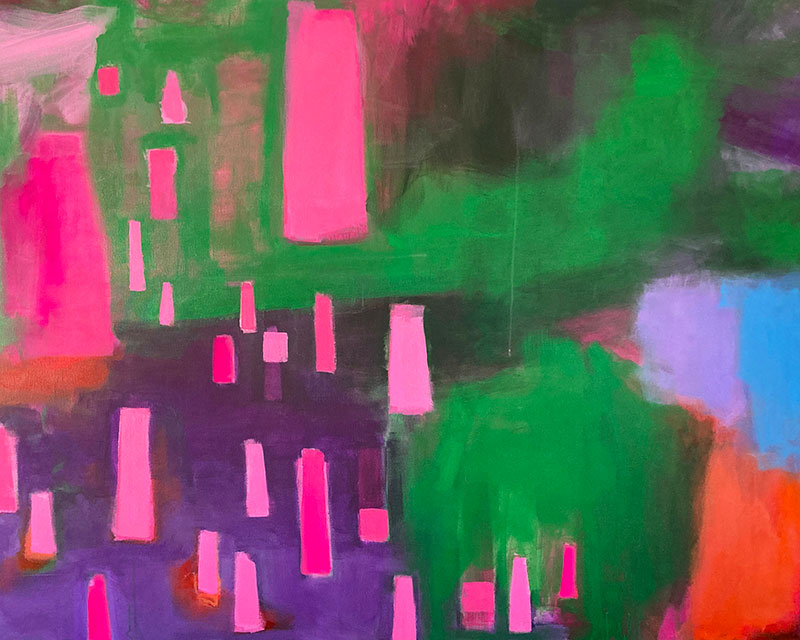
Ann Tracy, Fuchsia (Series: When I Didn’t Have a Broken Wing), 2020. Acrylic and paint pen on canvas. Photo by artist.
PhxArt: What is something about your process that might surprise viewers?
Tracy: I’ve worked with one particularly talented student-intern for a long time. She taught me the concept of the “art happy dance.” Now I do it when I first get in the studio because I’m so happy to be there—during painting when work is going well, when a great song comes on, and whenever a painting is officially done. It brings fun and movement into the space. The music in my studio changed with the pandemic. Moody, angsty stuff took a backseat. I needed something with a strong beat and soulful message, so I’ve been listening to R&B, hip-hop, and Motown. An interesting side effect has been that this music makes me feel proud about American culture.
Speaking of dancing, one time in Ireland, I shared studio space with a choreographer from Finland, so movement was her practice. The first day it was slightly distracting; I kept catching motion in my peripheral vision. But after that, I stopped noticing. It was like being in art school. As long as someone is in their own creative mind, I’ve no problem working near others.
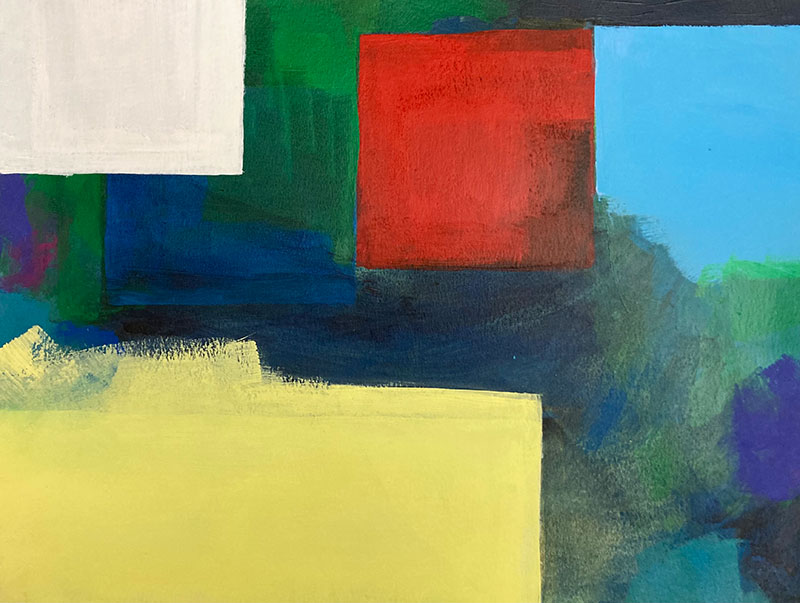
Ann Tracy, Eyeries no 2, 2021. Acrylic on paper. Photo by artist.
PhxArt: Who are your greatest artistic influences?
Tracy: The art world is changing. There are major exhibitions with artists who were previously shut out of the industry. As a disabled woman artist, I find their work and their stories inspiring. I’m talking about brilliant exhibitions like Hearts of Our People: Native Women Artists at the Minneapolis Art Institute; Queer Abstraction at the Des Moines Art Center; and 30 Americans at the Tucson Museum of Art, which featured the Rubell collection of major African-American artists of the past three decades. I got to meet Mera Rubell, and she’s just this lovely, real person. The artists involved in these exhibitions are more diverse, layered, and creative than others I’ve seen before. Contemporary art is my thing, and there are so many American artists to watch right now—it’s exciting.
While I only create 2D visual work, I’m a huge consumer of all the arts. A few favorites are modern dance and poetry. I got to hear Nikky Finney read at Phoenix Art Museum right before the pandemic started. THAT was a life experience. I also love music in intimate spaces—home concerts and small pubs. I’m happiest and in the zone when my entire life is surrounded by the arts.
PhxArt: What first inspired you to become an advocate for the arts, and what are some formative experiences that have shaped your activism through the years?
Tracy: I had mentors at art school in Minneapolis (MCAD) who encouraged a community approach to art: sharing resources and knowledge. Then I did an exchange at California College of Art and studied mural painting with Chicano muralist Malaquias Montoya. We painted two murals in Oakland. Doing large-scale group murals is as community-based as you can get, and so fun! Next I had the opportunity to go back to MCAD to be one of many print assistants to New York artist Mariam Shapiro. Later, I joined Dinnerware cooperative in Tucson, first as a member, then as vice-president with duties including chair of exhibitions, and then as a member of the board of directors. My professional life kept going in that direction, including teaching, mentoring, and advocacy. I wouldn’t want to live in a world without the arts, so I do whatever I can to help.
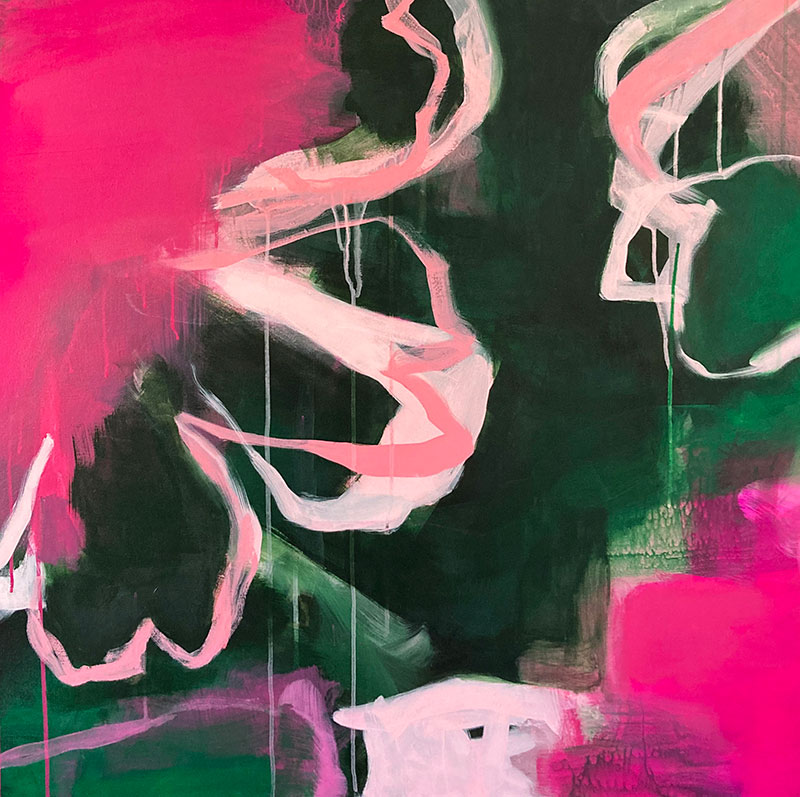
Ann Tracy, Purslane (Series: When I Didn’t Have a Broken Wing), 2021. Acrylic on canvas. Photo by artist.
PhxArt: What are some works, series, or projects you’re currently working on or have recently exhibited?
Tracy: In 2018, I had a solo exhibition at Rancho Linda Vista, an artist community in Oracle, AZ, about river confluences, or where two rivers meet. It was a mix of large photographs and hundreds of tiny sewn watercolors that were installed flowing across the gallery walls, mapping out specific rivers as they collided.
I was supposed to have my first international solo exhibition in Guadalajara in April 2020. The work was about atmospheric rivers—storm systems that are happening more frequently in this part of the country. Unfortunately, it was cancelled due to COVID.
More recently, this past winter I had new paintings up at the Tucson International Airport.
PhxArt: What can our community expect to see next from you?
Tracy: I’m going to continue the series of paintings that were featured at the Tucson International Airport. I do have exciting ideas brewing on something new, but I’m keeping it secret for now. I’ll say that it’s influenced by a science lab at the University of Arizona that studies the interconnectedness of a couple of natural elements I feel passionate about. It’s in the early stages; I haven’t been able to visit the lab due to COVID-19, but I’ve been busy reading their research available online.
I’ve also embraced the fact that I’ve always been a walking artist. This summer was spent wandering about northern Minnesota and keeping a visual journal on Instagram. My great grandfather and grand aunt were early photographers. My grand aunt made beautiful walking self-portraits. I’m hoping to exhibit our photos together—two single women artists walking and taking photos over a century apart from each other. I’m also planning handmade books featuring walking photos.
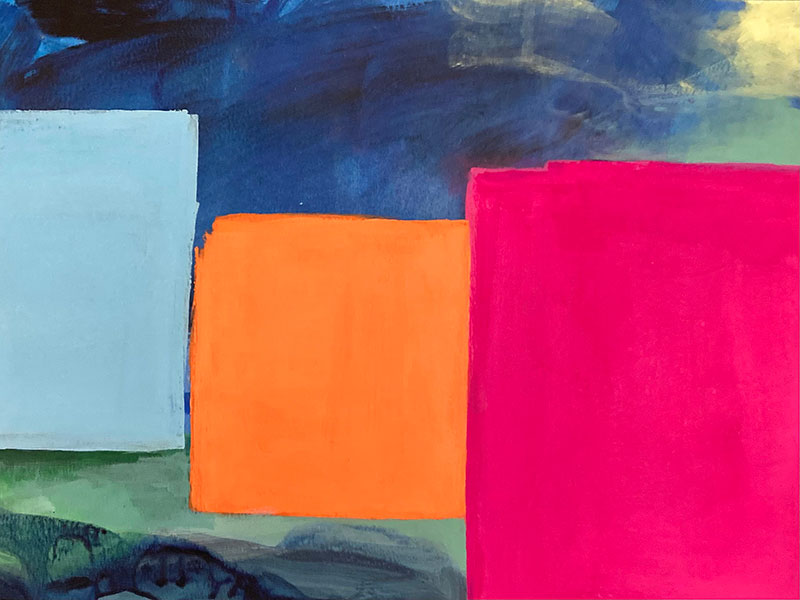
Ann Tracy, Eyeries no 3, 2021. Acrylic and paint pen on paper. Photo by artist.
SEE MORE
Ann Tracy is represented by ARTEZONA. To see more work by Ann, visit ARTEZONA.com or AnnTracyArt.com or follow her on Instagram @AnnTracyArt. The artist also exhibits work regularly at Contreras Gallery in Tucson.
#CreativeQuarantine
We’re curious how creatives are navigating the time of coronavirus. Ann Tracy shares what’s giving her life during the pandemic.
Tracy: How would we have gotten through the pandemic without writers, musicians, and actors? I’ve been consuming all things arts, and they keep me sane. But my savior was nature. The birds and the plants in my little back garden were my friends. I managed a stay at a cabin in Oak Creek (north of Sedona) in September, right in-between two surgeries. The only way I got through that was sitting at the crick in the shade, my feet in the cool running water. Nature is also what got my creative mind to settle.
I took a break from work about water and looked to land—to stone, plants, and flowers. I began with some free-flowing work about agates, a stone found in Northern Minnesota. I worked on small abstractions of Eyeries, the colorful village where I stay in Ireland. Then I felt ready to move back to larger work, influenced by specific plants I’ve seen in Ireland. I basically went on holiday in my mind to faraway places. The biggest factor was color. I just had to have bright color during all this stuff going on. It was also nice to be lost in the process of abstraction.
Categories
What can we help you find?
Need further assistance?
Please call Visitor Services at 602.257.1880 or email